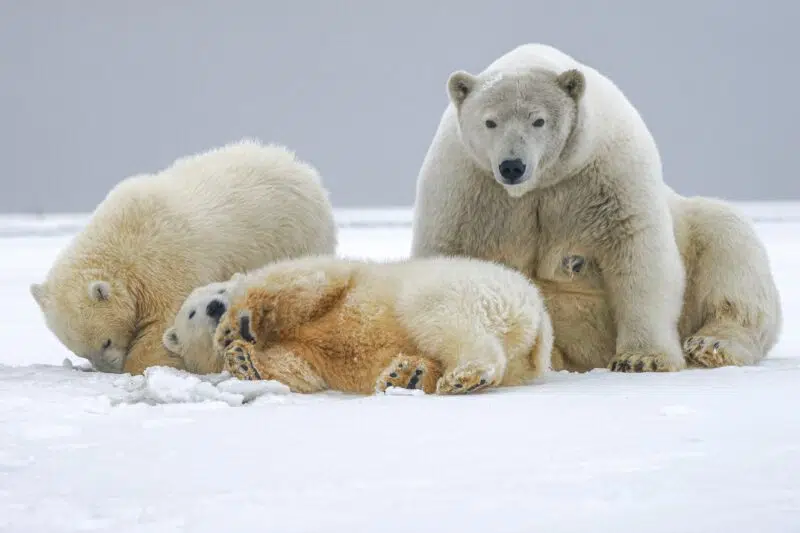Are you interested in the most endangered animals at the North Pole?
Animals native to the North Pole, which is in the middle of the Arctic Ocean, are often called Arctic animals. Here are some of the fascinating endangered animals that live in these frigid conditions.
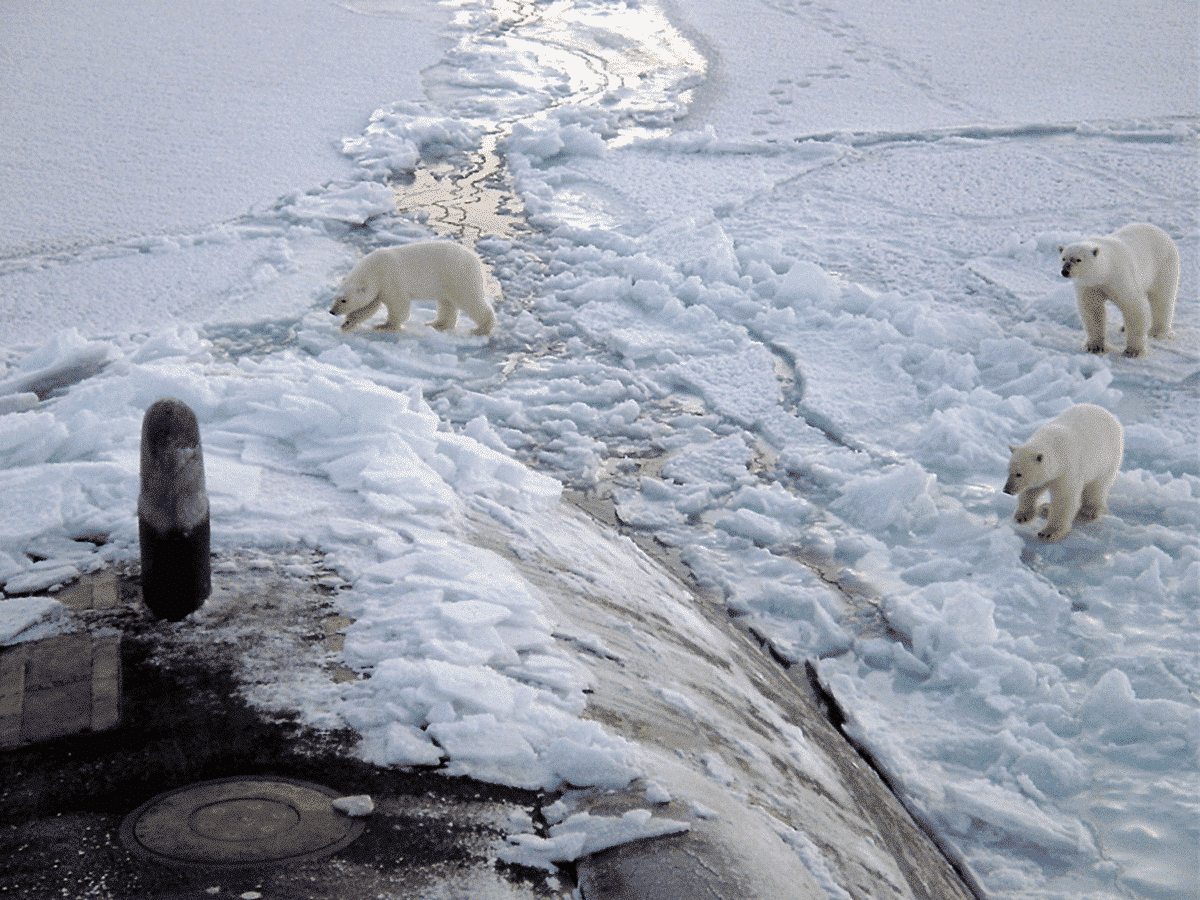
Arctic wildlife is facing a series of crises, courtesy of human activities such as climate change, hunting, and oil drilling. These challenges have pushed some Arctic animals to hit the road and migrate elsewhere.
Unfortunately, for those creatures that can’t just pack up and leave due to their cold climate adaptations, their populations are dwindling. This article zooms in on the plight of the 17 most endangered animals at the North Pole, shedding light on how the Arctic crisis is taking a toll on their survival.
Key Points
| # | Animal | Scientific Name | Threats and Causes of Endangerment |
|---|---|---|---|
| 1 | Ptarmigan | Lagopus muta | Warmer winter conditions, global warming, habitat fragmentation |
| 2 | Polar Bears | Ursus maritimus | Climate change, habitat loss due to melting ice |
| 3 | Beluga Whale | Delphinapterus leucas | Commercial whaling, predation by polar bears |
| 4 | Prairie Pigeon (Eskimo Curlew) | Eskimo curlew | Habitat loss, potential extinction |
| 5 | Walrus | Odobenus rosmarus | Climate change, loss of sea ice, extreme weather conditions |
| 7 | Musk Ox | Ovibos moschatus | Overhunting, population reduction, potential extinction |
| 8 | Wood Bison | Bison bison athabascae | Threatened due to population decline, habitat loss |
| 9 | Snowy Owl | Bubo scandiacus | Global warming, habitat loss, vulnerability to extinction |
| 10 | Caribou/Arctic Reindeer | Rangifer tarandus | Population decline, various threats contributing to decline |
| 11 | Narwhal | Monodon monoceros | Overfishing for ivory tusks, climate change, ship collisions |
| 12 | Arctic Peregrine Falcon | Falco peregrinus | DDT pesticide, significant population decline |
| 13 | Sei Whales | Balaenoptera borealis | Excessive commercial whaling, critically endangered |
| 14 | Arctic Wolf | Canis lupus arctos | Recently added to the Red List of Endangered Species |
| 15 | Ringed Seal | Pusa hispida | Population decline, habitat loss, protected under MMPA |
#1 Ptarmigan

Meet the Ptarmigan, a beautiful bird closely related to the prairie grouse, belonging to the Lagopus muta family. These birds inhabit alpine and arctic tundras in the northern hemisphere and prefer treeless areas in extremely frosty places. The white-tailed ptarmigan, a common species, calls the North Pole’s tundra home.
| Attribute | Information |
|---|---|
| Scientific Name | Lagopus muta |
| Habitat | Alpine and arctic tundras in the northern hemisphere |
| Preferred Environment | Treeless areas in extremely frosty places |
| Common Species | White-tailed ptarmigan |
| Threats | Warmer winter conditions, global warming |
| Population Impact | Serious decline, increasing fragmentation |
| Conservation Efforts | Petition to U.S. Fish and Wildlife Service |
| Request for protection under the Endangered Species Act | |
| Outcome of Petition | Unfortunately declined |
Despite their stunning existence, Ptarmigans face threats that have led to population decline and fragmentation. Efforts for protection were made, but unfortunately, the petition for safeguarding under the Endangered Species Act was declined. This raises concerns about the future of these unique birds in the wake of environmental challenges.
#2 Polar Bears
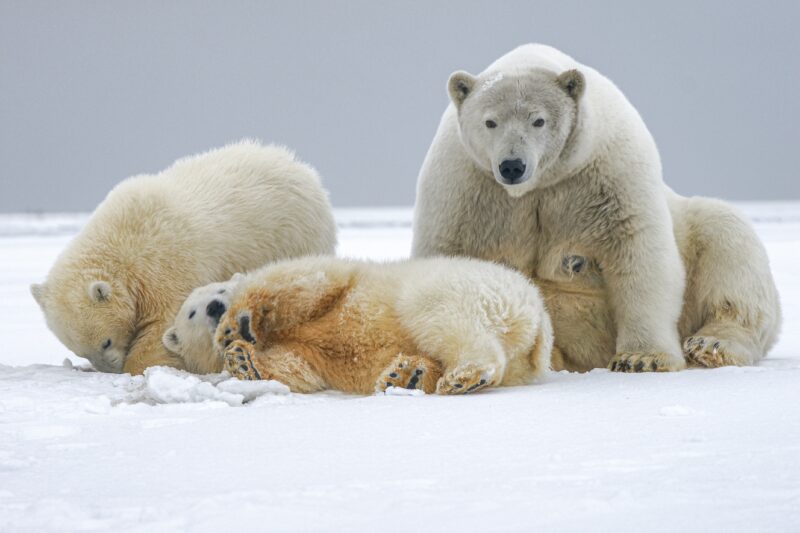
Enter the Polar Bear, scientifically identified as Ursus maritimus, a hypercarnivorous giant often synonymous with the North Pole. These magnificent creatures, typically found in the Arctic Circle, are critically endangered in the North Pole’s wildlife.
If you are a polar bear enthusiast you can discover the World’s Largest land predatore by reading our dedicated article on these predatores.
| Attribute | Information |
|---|---|
| Scientific Name | Ursus maritimus |
| Habitat | Primarily in the Arctic Circle |
| Size and Adaptation | Largest extant bear species, adult males up to 800 kg, adaptive to cold temperatures, spending their lives on sea ice |
| Status | Critically endangered |
| Dependency | Complete reliance on sea ice, categorized as marine mammals |
| Threat Level (2006) | Vulnerable to extinction, according to the International Union for Conservation of Nature (IUCN) |
| Primary Threat | Climate change, leading to melting of ice packs and habitat loss |
These carnivorous giants, known for their prowess, are on the brink of extinction. Designated as critically endangered by the IUCN since 2006, their population decline is primarily attributed to climate change. The melting of ice packs, integral to their way of life, poses a severe threat, emphasizing the urgent need for conservation efforts to secure the future of these remarkable marine mammals.
#3 Beluga Whale

Meet the Beluga Whale, also known as the white whale, a popular resident of the Arctic Ocean’s northeast side. These enchanting creatures are distinguished by their bright white color, undergoing a remarkable transformation from grey at birth to brown after a few months, culminating in the iconic white hue in adulthood.
| Attribute | Information |
|---|---|
| Common Name | Beluga Whale |
| Habitat | Northeast side of the Arctic Ocean |
| Color Transformation | Grey at birth, turns brown, eventually becomes bright white |
| Distinctive Feature | Striking bright white color |
| Teeth | Approximately 40 teeth, showcasing their skill as predators |
| Predators | Common prey for polar bears and large whales |
| Human Impact | Commercial whaling adds to the factors threatening their existence |
These marine marvels not only possess a captivating appearance but also boast around 40 teeth, making them skilled predators. Unfortunately, factors like commercial whaling and being prey for larger animals contribute to the rapid extinction risk for these extraordinary beings. Conservation efforts are essential to secure the future of the Beluga Whale and protect their vital role in the Arctic ecosystem.
#4 Prairie Pigeon

The Prairie Pigeon, scientifically known as Eskimo curlew, is a species teetering on extinction’s edge, primarily due to habitat loss. These exquisite shorebirds call the Arctic tundra of the North Pole home, engaging in migratory patterns dictated by seasonal changes.
| Attribute | Information |
|---|---|
| Scientific Name | Eskimo curlew |
| Habitat | Arctic tundra of the North Pole |
| Migration Pattern | Migratory birds, shifting with the seasons |
| Conservation Status | Critically endangered, listed by the IUCN |
| Concerns | Ongoing population decline, prompting concerns about potential extinction |
| Contradictory Claims | Unreliable sources suggest possible extinction, while official authorities have not confirmed it yet |
Despite their captivating existence, Prairie Pigeons face a grim reality with habitat loss pushing them to critical endangerment. While some sources claim their extinction, it’s crucial to note that official authorities have not officially confirmed their disappearance, emphasizing the importance of accurate information in assessing their conservation status.
#5 Walrus
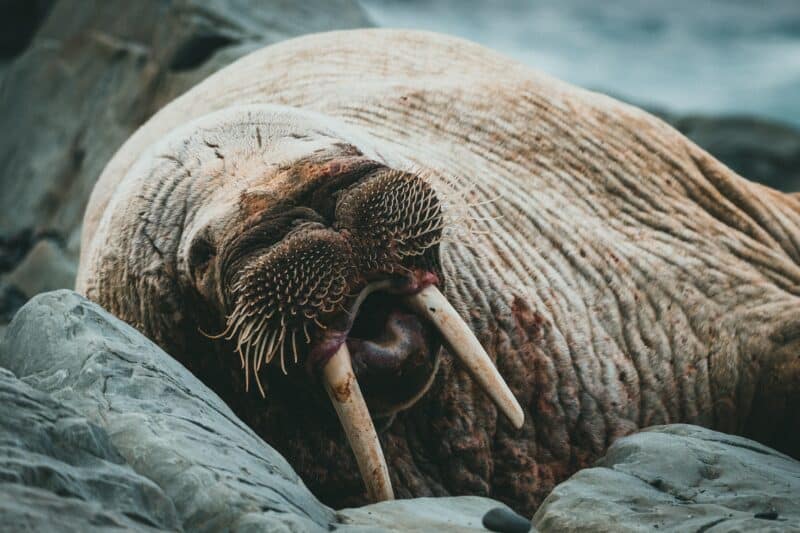
Welcome to the world of the Walrus, a creature mirroring the plight of polar bears, relying entirely on ice packs for survival, particularly crucial for their calves. However, the alarming thawing of ice due to extreme climate conditions and global warming poses a formidable threat to these majestic creatures.
| Attribute | Information |
|---|---|
| Habitat Dependency | Fully dependent on ice packs for survival, critical for nurturing calves |
| Geographic Range | Inhabit frosty zones of the Arctic Ocean, also found in the Pacific and Atlantic Oceans |
| Preferred Locations | Ocean shores with shallow water, providing icy floors for calf nurturing |
| Climate Impact | Extreme climate conditions and global warming affecting ice pack availability |
| Population Decline | Substantial decline due to the challenges posed by climate change |
These marine giants, accustomed to the frigid Arctic zones, now face a dire situation as climate change disrupts the availability of their essential ice packs. The result is a significant population decline, emphasizing the urgent need for conservation measures to ensure the Walrus’s survival in the face of changing environmental conditions.
#7 Musk Ox

Meet the Muskox, scientifically labeled Ovibos moschatus, a majestic mammal typically found in the far northern regions, specifically native to the Arctic. These creatures boast shaggy-haired fur covering their entire body, a characteristic that has adorned the Arctic landscape for thousands of years.
| Attribute | Information |
|---|---|
| Scientific Name | Ovibos moschatus |
| Habitat | Native to the Arctic |
| Appearance | Shaggy-haired fur, a distinctive feature |
| Historical Presence | Inhabiting the Arctic region for thousands of years |
| Population Decline | Devastating reduction due to overhunting, dropping to just 500 individuals at one point |
| Conservation Status | Enlisted as endangered species since the population decline |
| Current Population | Contradictory information: Some sources state a stable number of 40,000 individuals |
Once thriving in the Arctic, Muskox populations faced a drastic reduction, plummeting to a mere 500 individuals due to overhunting. Recognizing the urgency, the species is now enlisted as endangered. However, conflicting information surrounds their current status, with some sources suggesting a stable population of 40,000 individuals. The situation underscores the need for accurate data and continued conservation efforts for the Muskox’s survival.
#8 Wood Bison

Have you ever heard of the Wood Bison? Scientifically identified as Bison bison Athabasca, it is a unique subspecies of mountain bison primarily native to far northern regions, also recognized as the wood or mountain buffalo.
| Attribute | Information |
|---|---|
| Scientific Name | Bison bison athabascae |
| Common Names | Wood Bison, Wood Buffalo, Mountain Buffalo |
| Habitat | Mainly native to far northern regions |
| Conservation Status | Enlisted as a threatened species under the Species at Risk Act in 2003 |
| Threatening Factors | Constant population decline |
| Updated Status | Later elevated to the list of endangered animals by authorities |
This distinctive northern subspecies, recognized for its rarity, faced a threat to its existence, leading to its classification as a threatened species under the Species at Risk Act in 2003. Acknowledging the persistent population decline, authorities later upgraded the Wood Bison to the list of endangered animals, emphasizing the need for conservation measures to safeguard this unique subspecies.
#9 Snowy Owl
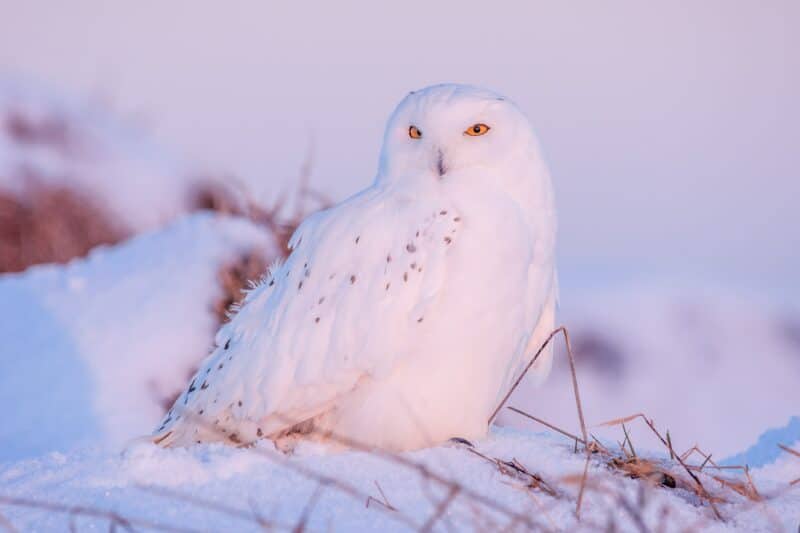
Meet the Snowy Owl, scientifically identified as Bubo scandiacus, a unique species commonly found in regions near the North Poles. Because of its appearance, it has often become synonymous with the Arctic and is on our list of Top 10 Snowy animals! These captivating creatures, also known as white or polar owls, belong to a large family of distinctive owls.
| Attribute | Information |
|---|---|
| Scientific Name | Bubo scandiacus |
| Common Names | Snowy Owl, White Owl, Polar Owl |
| Habitat | Native to Arctic Regions of the North Pole, often referred to as Arctic Owls |
| Appearance | Male snowy owls exhibit pure bright white skin, while females have dark brown flecks on their white skin |
| Migration Pattern | Migratory birds, changing breeding locations within the Arctic regions |
| Population Estimation | Challenging due to constant migration, experts believe the population is decreasing |
| Primary Threat | Global warming identified as the leading cause of population decline |
| Conservation Status | Enlisted as vulnerable to global extinction by authorities |
Despite their uniqueness and distinction as Arctic Owls, Snowy Owls face the challenging threat of global extinction. The experts point to global warming as the primary factor behind their declining population, leading authorities to designate them as vulnerable to the risk of disappearing from the global landscape.
#10 Caribou / Arctic Reindeer
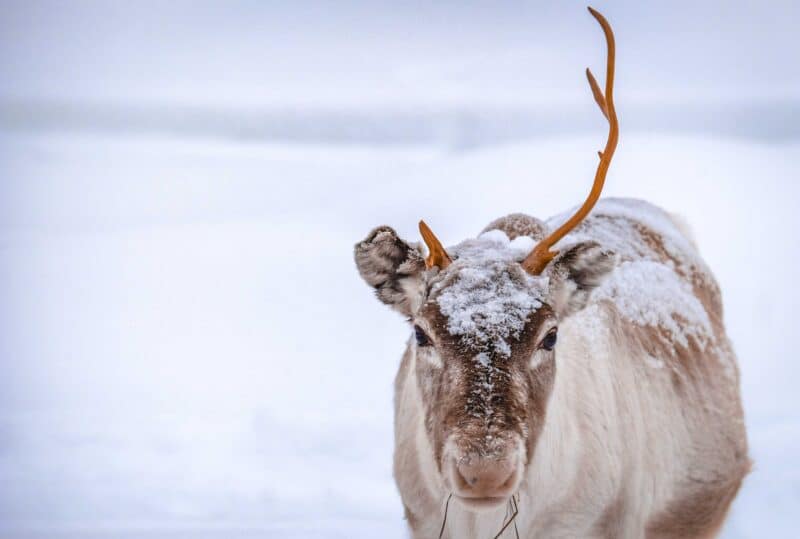
Caribou, also known as Arctic Reindeer, a creature of the far north that has been marked as vulnerable to extinction. These unique beings, the largest species of deer, call the Arctic tundra and numerous Arctic islands home.
| Attribute | Information |
|---|---|
| Common Names | Caribou, Arctic Reindeer |
| Habitat | Native to the Arctic tundra and various Arctic islands |
| Size | The largest species of deer size |
| Conservation Status | Enlisted as vulnerable to extinction |
| Population Decline | Declining for over a decade |
| Magnitude of Decline | Estimated drop from 4.7 million to 2.1 million, constituting a total loss of 2.6 million individuals |
Despite their significance and size, Caribou face a troubling reality as their population steadily declines. Over the past decade, their numbers have dwindled significantly, with an estimation revealing a loss of 2.6 million individuals from an estimated 4.7 million, highlighting the urgent need for conservation efforts to reverse this decline and secure their place in the Arctic ecosystem.
#11 Narwhal
Introducing the Narwhal, a captivating marine creature enlisted as one of the most endangered animals at the North Pole. These medium-sized wonders, often referred to as the unicorn of the sea, possess a distinctive feature—a long ivory tusk protruding from their heads, adding to their commercial value but tragically making them targets of overfishing.
| Attribute | Information |
|---|---|
| Unique Feature | Long ivory tusk, earning them the title of the unicorn of the sea |
| Commercial Value | Tusk adds to commercial appeal, leading to overfishing for ivory tusks |
| Color Transformation | Born blue-gray, change to blue-black as juveniles, mottled gray as adults, and eventually grow all-white when fully sexually matured |
| Habitat History | Native to Arctic regions near the North Pole |
| Current Population | Recent survey reports only three species left in the Arctic regions |
| Future Threats | Expected devastating decrease due to frequent ship collisions and climate change |
| Conservation Status | IUCN reportedly added them to the Red List of critically endangered animals at the North Pole |
Beyond their enchanting appearance, Narwhals face critical threats from overfishing, impacting their unique tusks. A recent survey reveals a stark decline in their population, with the expectation of further devastation due to frequent ship collisions and climate change. The IUCN’s inclusion of Narwhals on the Red List highlights the urgency of conservation efforts to preserve this extraordinary species in the North Pole ecosystem.
#12 Arctic Peregrine Falcon
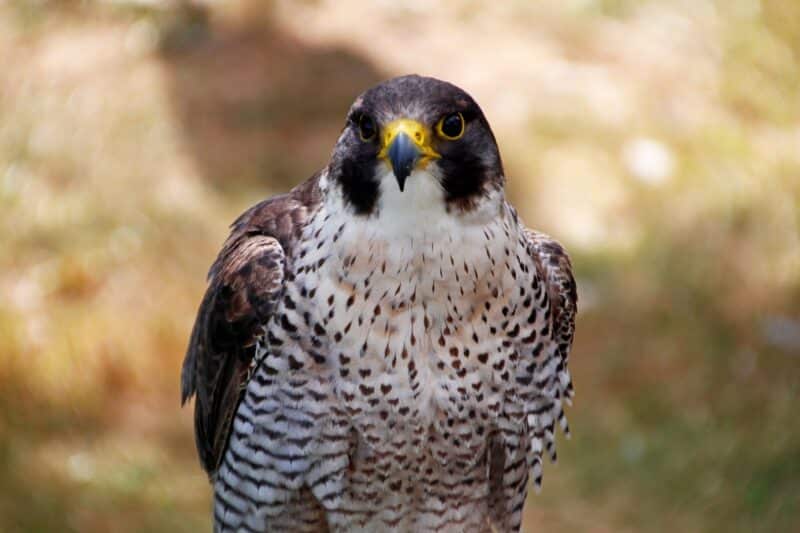
Meet the Peregrine Falcon, scientifically named Falco peregrinus, often referred to simply as peregrine and formerly known as the duck hawk in North America near the Northern Circle. This large-sized falcon, belonging to the Falconidae family, exhibits captivating color variations, with a blue-grey back contrasting the white underparts and a distinct totally black head.
| Attribute | Information |
|---|---|
| Scientific Name | Falco peregrinus |
| Common Names | Peregrine Falcon, Duck Hawk (formerly in North America near the Northern Circle) |
| Size | Large-sized falcon |
| Color Variations | Blue-grey back, white underparts, totally black head |
| Flying Speed | Astounding 320 km/h (200 mph), making it the fastest member of the animal kingdom |
| Conservation Status | Identified as endangered |
| Primary Threat | Drastic population decline attributed to the harmful pesticide DDT |
| Historical Categorization | Listed as an endangered species in 1984 |
| Population Decline | An 80% decline since 1984, with expectations of further decline |
Despite its record-breaking speed, the Peregrine Falcon faces endangerment, primarily due to the detrimental effects of the pesticide DDT. Categorized as endangered since 1984, this species has witnessed an alarming 80% decline in its population, emphasizing the urgency of conservation efforts to safeguard this remarkable falcon from further decline.
#13 Sei Whales
Introducing the Sei Whale, a distinctive marine creature indigenous to the Northern Hemisphere, now teetering on the brink of extinction and recognized as the most critically endangered animal by the IUCN.
Unfortuantely this stunning animal is also on our list of 11 most endangered whales.
| Attribute | Information |
|---|---|
| Scientific Name | Balaenoptera borealis |
| Conservation Status | Identified as the most critically endangered animal by the IUCN |
| Baleen Whale Rank | Third-largest among baleen whales |
| Type | Unique toothed baleen whale |
| Threatening Factor | Nearing global extinction primarily due to excessive commercial whaling |
The Sei Whale, scientifically known as Balaenoptera borealis, stands as a unique toothed baleen whale and holds the unfortunate distinction of being the most critically endangered animal, perilously close to extinction. Like many of its marine counterparts, this gigantic mammal faces the imminent threat of global extinction, primarily driven by the relentless impact of excessive commercial whaling. Urgent conservation measures are crucial to prevent the disappearance of this extraordinary species from our planet.
#14 Arctic Wolf
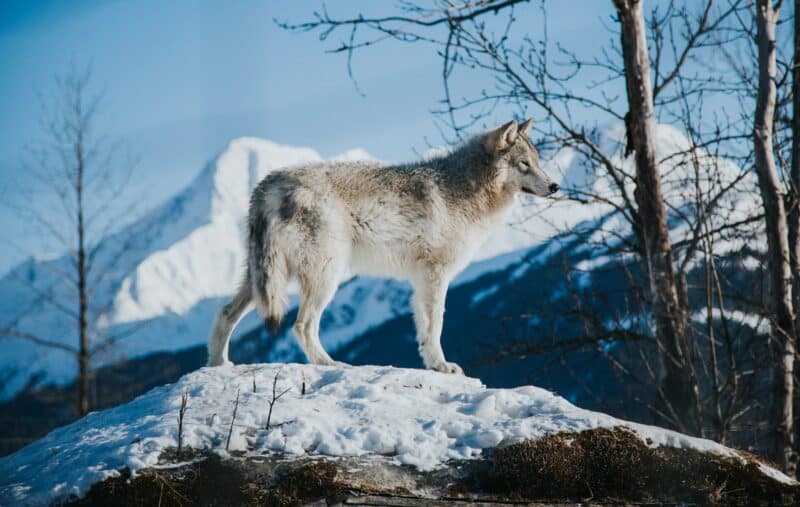
Meet the Arctic Wolf, scientifically identified as Canis lupus arctos, also fondly known as the white wolf or polar wolf owing to its strikingly white fur.
| Attribute | Information |
|---|---|
| Scientific Name | Canis lupus arctos |
| Common Names | Arctic Wolf, White Wolf, Polar Wolf |
| Habitat | Native to the High Arctic tundra of the Northern Pole |
| Distribution | Some species exist in Southern regions, albeit in significantly smaller numbers |
| Conservation Status | Recently added to the Red List of Endangered Species by the IUCN |
This fluffy inhabitant of the High Arctic tundra, the Arctic Wolf, has recently found itself in the spotlight of endangerment. Previously, their conservation status may not have been a focal point, but recent declarations by reliable sources indicate that the IUCN has added them to the Red List of Endangered Species, emphasizing the need for concerted efforts to ensure the survival of this remarkable species.
#15 Ringed Seal

Last but not least the Ringed Seal, scientifically identified as Pusa hispida, an Arctic native calling the Northern Hemisphere home.
| Attribute | Information |
|---|---|
| Scientific Name | Pusa hispida |
| Size | Relatively small seal |
| Family | Belongs to the order Carnivora of the Mammalia family |
| Distinctive Features | Body covered with distinctive dark spots, named for grey rings on its body |
| Habitat Preference | Inhabits snow-covered caves, known to build their own snow caves for breeding and protecting pups |
| Conservation Status | Enlisted as endangered and protected under the Marine Mammal Protection Act |
This small yet distinctive member of the seal family, the Ringed Seal, has faced a recent decline in population. In response to this trend, they are now recognized as endangered and benefit from protection under the Marine Mammal Protection Act. Urgent conservation measures are crucial to safeguard these unique seals and their role in the Arctic ecosystem.
Summary of the Most Endangered Animals at the North Pole
Despite its glacial climate and frosty terrain we can see that the North Pole is still home to countless of amazing animals. Sadly most of them are in a precarious situation due to climate change – in other words it is yet another reason for us to be more caring about our beautiful planet and its creatures.
Thank you for reading this article! If you still want to learn more about endangered species from other corners of the world go and have a look at our article The Most Endangered Animals or Animals in The North Pole.
Frequently Asked Questions
The Sei Whale holds the unfortunate distinction of being the most critically endangered species in the North Pole, as recognized by the International Union for Conservation of Nature (IUCN).
Among the endangered animals in the Arctic, the Arctic Wolf has recently been added to the Red List of Endangered Species by the IUCN.
Several animals inhabit the North Pole, with notable examples being the Polar Bear, Arctic Fox, Beluga Whale, and Narwhal. Each species is uniquely adapted to the harsh Arctic conditions.
a. Climate Change: Polar bears rely on sea ice for hunting seals, their primary food source. The melting of ice due to climate change results in habitat loss and reduced hunting opportunities.
b. Oil Drilling: Human activities, including oil drilling in the Arctic, pose a threat to polar bear habitats, leading to increased disturbances and potential oil spills.
c. Hunting: Although regulated, hunting continues to impact polar bear populations. Climate change exacerbates this issue as bears are forced to travel longer distances to find food, making them more vulnerable to hunting pressures.
- Octopus Stuck to Diver’s Back and Won’t Come Off - April 25, 2024
- Magpie Bird Is Reunited with Her Dog Best Friend - April 24, 2024
- Dog Saves Another Dog From Drowning in Fish Pond - April 23, 2024

